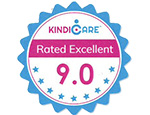Nutrition in childcare
Why is good nutrition important for my child?
It is important your child has nutritious food to give your child all the nutrients their bodies need to grow, and to develop and reach their physical and mental potential.
On the flip side, poor food choices and unhealthy eating habits in childhood can lead to a range of health problems later in life.
How can my child’s nutritional needs be met?
The National Health and Medical Research Council of Australia (NHMRC) recommends children and adolescents maintain a varied diet which includes the five main food groups. According to the NHMRC, children and adolescents need to be encouraged to eat plenty of:
- vegetables, fruit and legumes
- cereals (including breads, rice, pasta and noodles) preferably wholegrain
The Council also states that a healthy diet includes:
- lean meat, fish, poultry
- milks, yogurts, cheeses
- limited servings of saturated fats, margarine, butter and oils.
The balance of these food groups is essential for maintaining your child’s health and well being. You should encourage your child to drink plenty of water throughout the day – the NHMRC’s drink of choice!
Healthy snacks throughout the day will also help maintain your child’s energy levels.
How can my child be encouraged to gain an understanding of healthy food?
Childcare staff play an important role in supporting children to develop a healthy and positive attitude towards good food choices. They do this through strategies and activities such as:
- Involving children in creating a healthy menu
- Encouraging younger children and toddlers to talk about ‘healthy’ and ‘not so healthy’ food choices early on
- Providing children with opportunities to eat food and engage in the mealtime routines of different cultures
- Talking with children about nutritious food during mealtimes. Staff should also model healthy eating practices for children
- Making sure mealtimes are pleasant occasions, where children and staff can socialise with each other
- Allowing children to exercise their independence and to make some choices during mealtimes
- Including healthy food toys in the ‘home corner’ at the service to encourage children’s investigative play
Tips for providing healthy food for children
- Choose a variety of foods, using Nutrition Australia’s Healthy Eating Pyramid as a guide. The latest version of the Healthy Eating Pyramid can be viewed or downloaded from the Nutrition Australia website: www.nutritionaustralia.org
- There are many different types of breads available that can be used as part of a healthy lunch. These include different types of sandwich bread such as multigrain, wholemeal, white, high fibre, rye, as well as rolls and flat breads
- Mix and match healthy bread fillings, such as:
- lean meats, meat alternatives and dairy foods such as ham, chicken, beef, tofu, eggs and cheese
- tinned fish such as tuna, salmon and sardines
- vegetables such as tomato, celery, carrots, sprouts and lettuce
- healthy spreads such as vegemite, cream cheese spreads, etc.
- Provide a variety of healthy snacks, including fresh fruit, cheese cubes, vegetable sticks, healthy dips, rice cakes, pikelets, dried fruits and mixed nuts
At Wiggles & Giggles Wentworthville, we support the Munch and move programme which is a NSW Health initiative that supports the healthy development of children birth to 5 years.
Call us on (02) 9631 0244 if you have any questions/concerns.
(Source: Starting Blocks – Australian Children’s Education & Care Quality Authority)




Recent Comments